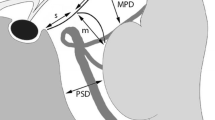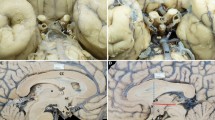Abstract
Introduction
Liliequist membrane (LM) is the most important anatomic structure for the success of endoscopic third ventriculostomy (ETV). Identification of this membrane is difficult with conventional MRI techniques. The purpose of this retrospective study is to determine the impact of three-dimensional sampling perfection with application-optimized contrasts using different flip-angle evolutions (3D-SPACE) sequence with variant flip-angle mode (VFAM) in the assessment of LM at 3-T MRI devices.
Methods
3D-SPACE with VFAM images were obtained in 445 patients. LM visibility and integrity were scored as 0 (good), 1 (moderate), and 2 (poor) on these images for each parts (sellar, diencephalic, and mesencephalic) and overall of the membrane.
Results
According to the LM overall integrity scores, 11 % (48 cases) of the patients had perforated membrane. According to subsegmental integrity scores, sellar part was completely intact in 63 % of patients, diencephalic segment was completely intact in 60 % of the patients, and mesencephalic segment was completely intact in 95 % of the patients. Visibility scores of the third ventricle inferior wall were significantly higher in the patients with intact LM (p = 0.001). There was not any statistically significant relationship between LM pattern and overall integrity (p = 0.352). LM attachment sites could be detected easier in the patients who had better visibility of third ventricle inferior wall or intact LM (p < 0.001 for both).
Conclusion
3D-SPACE technique is a useful alternative for the evaluation of morphology, integrity, individual variations, topographic relationships, and visibility of LM since it has some advantages including lower SAR values, fewer artifacts, and high-resolution images.




Similar content being viewed by others
References
Zhang XA, Qi ST, Huang GL, Long H, Fan J, Peng JX (2012) Anatomical and histological study of Liliequist’s membrane: with emphasis on its nature and lateral attachments. Childs Nerv Syst 28:65–72
Liliequist B (1956) The anatomy of the subarachnoid cisterns. Acta Radiol 46:61–71
Mortazavi MM, Rizq F, Harmon O et al (2015) Anatomical variations and neurosurgical significance of Liliequist’s membrane. Childs Nerv Syst 31:15–28
Fushimi Y, Miki Y, Takahashi JA et al (2006) MR imaging of Liliequist’s membrane. Radiat Med 24:85–90
Buxton N, Vloeberghs M, Punt J (1998) Liliequist membrane in minimally invasive endoscopic neurosurgery. Clin Anat 11:187–190
Fushimi Y, Miki Y, Ueba T et al (2003) Liliequist membrane: three-dimensional constructive interference in steady state MR imaging. Radiology 229:360–365
Kartal MG, Ocakoglu G, Algin O (2015) Feasibility of 3-dimensional sampling perfection with application optimized contrast sequence in the evaluation of patients with hydrocephalus. J Comput Assist Tomogr 39:321–328
Anık I, Ceylan S, Koc K, Anık Y, Etus V, Genc H (2011) Membranous structures affecting the success of endoscopic third ventriculostomy in adult aqueductus sylvii stenosis. Minim Invasive Neurosurg 54:68–74
Basaldella L, Fiorindi A, Sammartino F, De Caro R, Longatti P (2014) Third ventriculostomy site as a neuroreceptorial area. Childs Nerv Syst 30:607–611
Etus V, Solakoglu S, Ceylan S (2011) Ultrastructural changes in the Liliequist membrane in the hydrocephalic process and its implications for the endoscopic third ventriculostomy procedure. Turk Neurosurg 21:359–366
Ward JD (2003) Clinician’s commentary. Radiology 229:365
Algin O, Turkbey B (2012) Evaluation of aqueductal stenosis by 3D sampling perfection with application-optimized contrasts using different flip angle evolutions sequence: preliminary results with 3T MR imaging. AJNR Am J Neuroradiol 33:740–746
Mugler JP 3rd (2014) Optimized three-dimensional fast-spin-echo MRI. J Magn Reson Imaging 39:745–767
Wang J, Wu Y, Yao Z, Yang Z (2014) Assessment of pituitary micro-lesions using 3D sampling perfection with application-optimized contrasts using different flip-angle evolutions. Neuroradiology 56:1047–1053
Kartal MG, Algin O (2014) Evaluation of hydrocephalus and other cerebrospinal fluid disorders with MRI: an update. Insights Imaging 5:531–541
Wong SK, Mobolaji-Iawal M, Arama L et al (2014) Atherosclerosis imaging using 3D black blood TSE SPACE vs 2D TSE. World J Radiol 6:192–202
Yasargil MG, Kasdaglis K, Jain KK, Weber HP (1976) Anatomical observations of the subarachnoid cisterns of the brain during surgery. J Neurosurg 44:298–302
Acknowledgments
Some study subjects have been previously reported in our previously published 3D-SPACE papers; however, this paper is entirely different than previously published studies.
Author information
Authors and Affiliations
Corresponding author
Ethics declarations
We declare that our study has been approved by the Ataturk Training and Research Hospital Ethics Committee and has therefore been performed in accordance with the ethical standards laid down in the 1964 Declaration of Helsinki and its later amendments. We declare that all patients gave informed consent prior to inclusion in this study.
Conflict of interest
We declare that we have no conflict of interest.
Rights and permissions
About this article
Cite this article
Algin, O., Kılın, M., Ozmen, E. et al. Assessment of Liliequist membrane by 3D-SPACE technique at 3 T. Neuroradiology 58, 637–647 (2016). https://doi.org/10.1007/s00234-016-1669-y
Received:
Accepted:
Published:
Issue Date:
DOI: https://doi.org/10.1007/s00234-016-1669-y




